30.01.2025
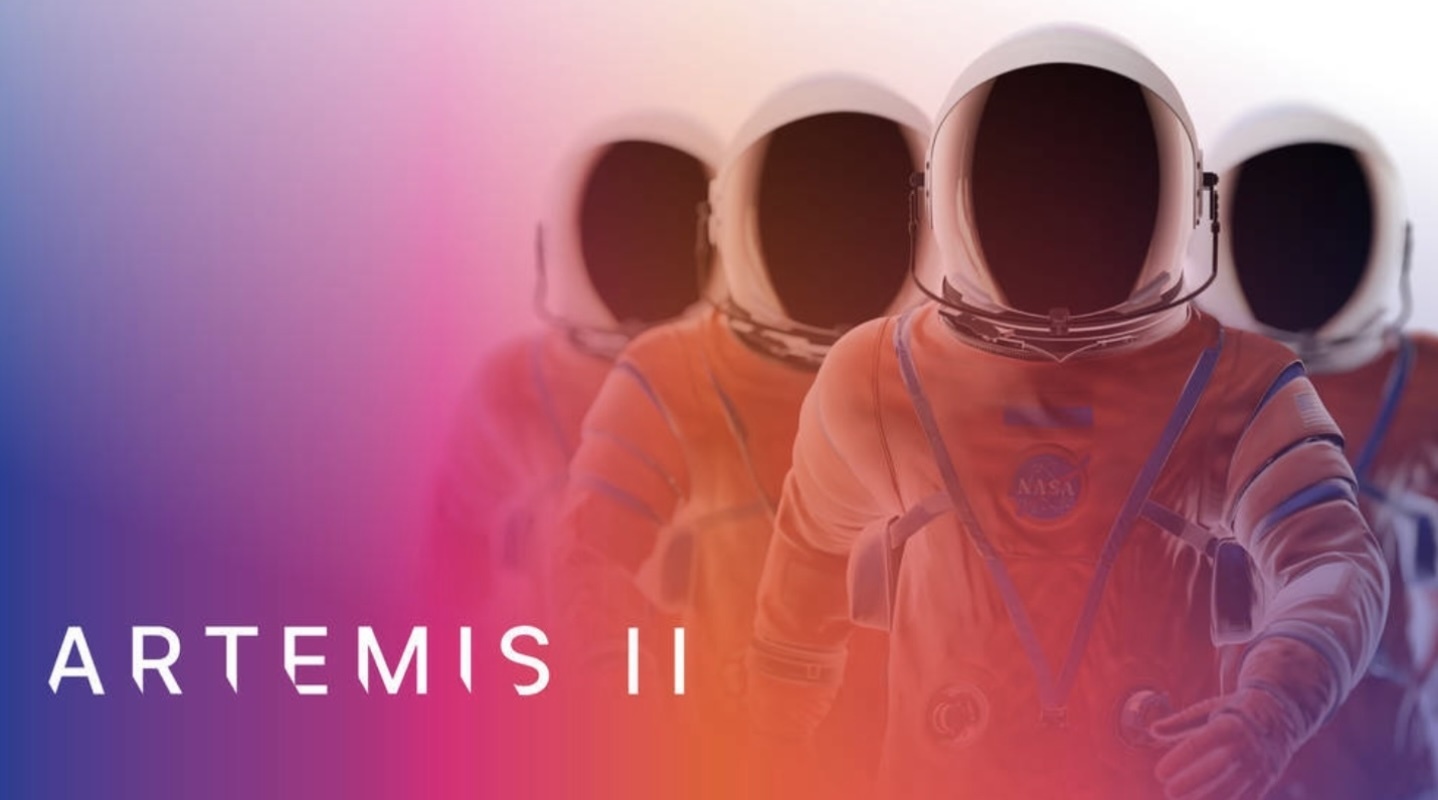
How to Fly NASA’s Orion Spacecraft
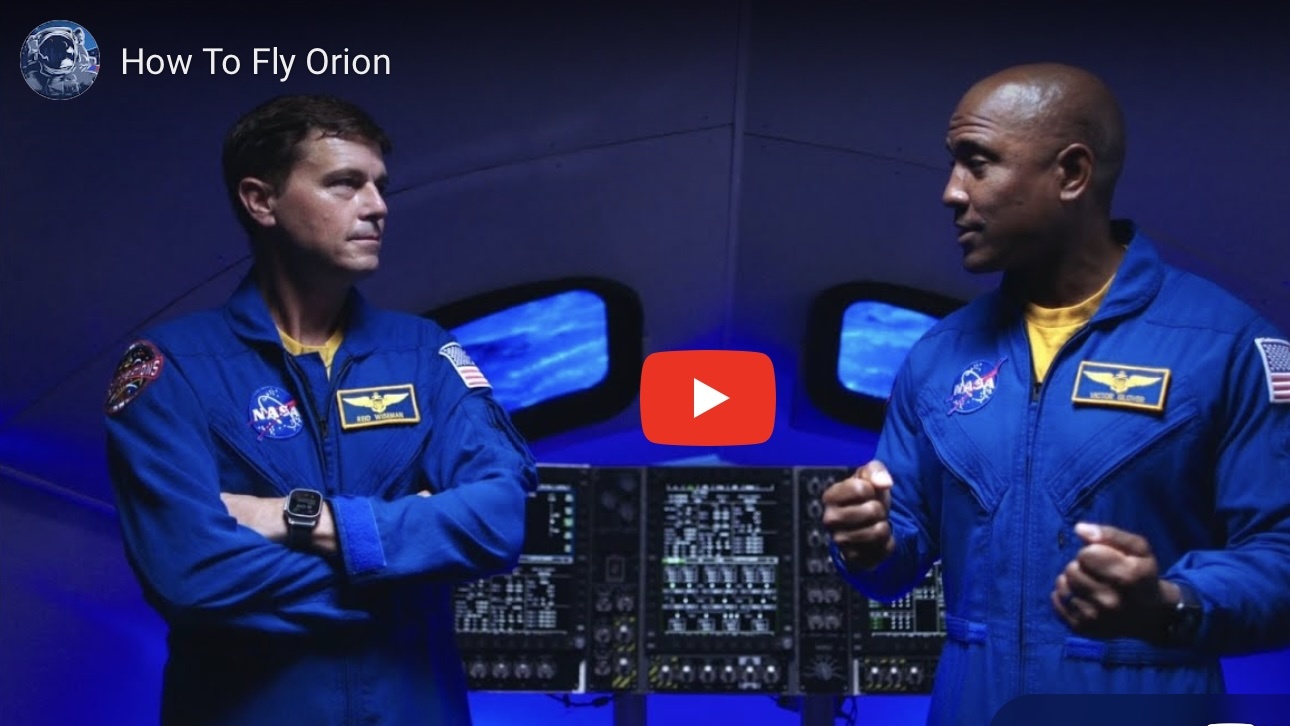
During the Artemis II mission to the Moon, NASA astronauts Reid Wiseman and Victor Glover will take control and manually fly Orion for the first time, evaluating the handling qualities of the spacecraft during a key test called the proximity operations demonstration. This is how to fly Orion.
On NASA’s Artemis II test flight, the first crewed mission under the agency’s Artemis campaign, astronauts will take the controls of the Orion spacecraft and periodically fly it manually during the flight around the Moon and back. The mission provides the first opportunity to ensure the spacecraft operates as designed with humans aboard, ahead of future Artemis missions to the Moon’s surface.
The first key piloting test, called the proximity operations demonstration, will take place after the four crew members — NASA’s Reid Wiseman, Victor Glover, and Christina Koch, and CSA (Canadian Space Agency) astronaut Jeremy Hansen — are safely in space, about three hours into the mission. To evaluate the spacecraft’s manual handling qualities, the crew will pilot Orion to approach and back away from the detached upper stage of the SLS (Space Launch System) rocket.
Crew members participating in the demonstration will use two different controllers, called rotational and translational hand controllers, to steer the spacecraft. Three display screens provide the astronauts with data, and another device, called the cursor control device, allows the crew to interact with the displays.
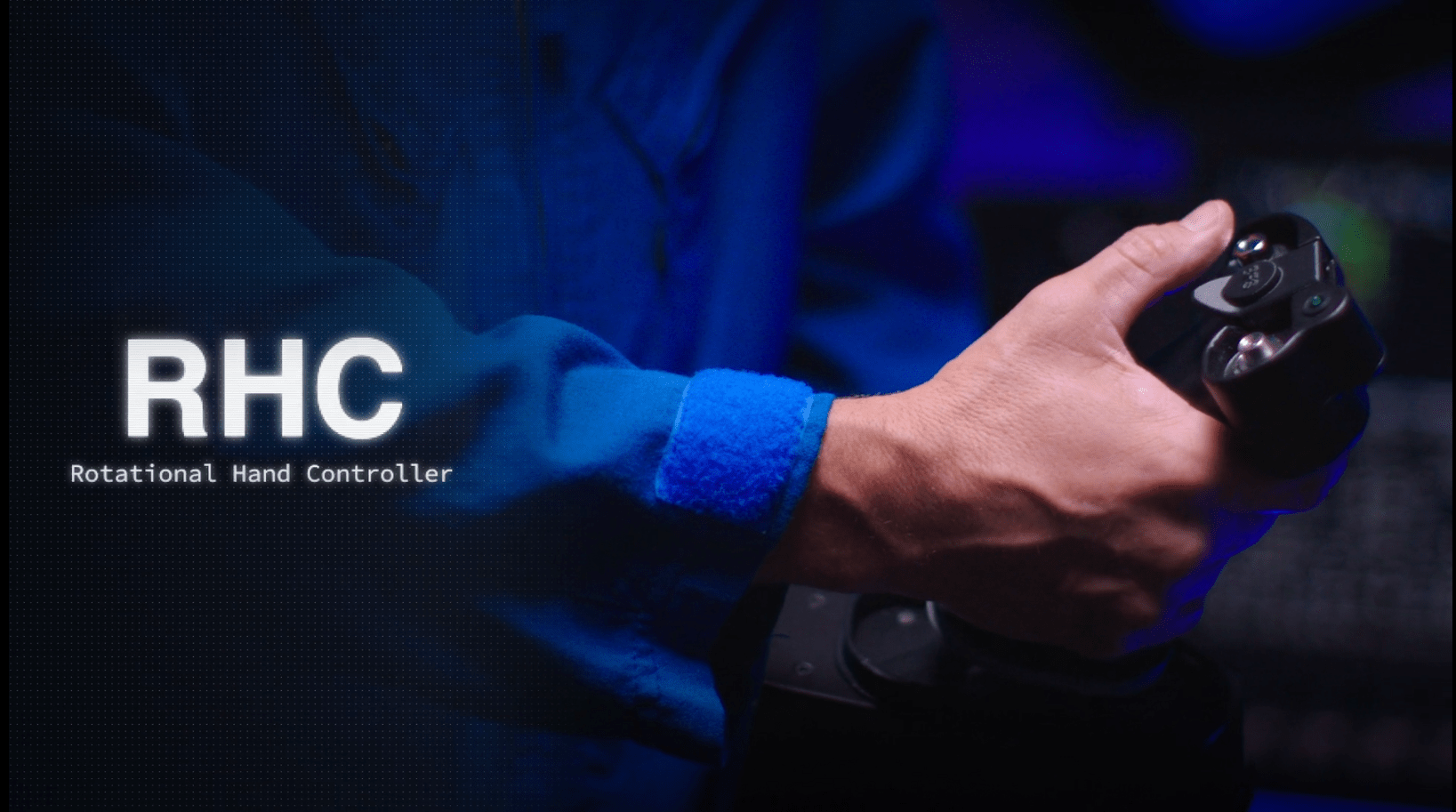
“On Artemis II, most of the time the spacecraft will fly autonomously, but having humans aboard is a chance to help with future mission success,” said Reid Wiseman. “If something goes wrong, a crewmember can jump on the controls and help fix the problem. One of our big goals is to check out this spacecraft and have it completely ready for our friends on Artemis III.”
The commander and pilot seats are each equipped with a rotational hand controller (RHC), gripped in the right hand, to rotate the spacecraft. It controls Orion’s attitude, or the direction the spacecraft is pointing. If the crew wants to point Orion’s nose left, the RHC is twisted left — for nose right, they will twist the RHC right. Similarly, the RHC can control the nose to pitch up or down or roll right or left.
The translational hand controller (THC), located to the right or left of the display screens, will move Orion from one point to another. To move the spacecraft forward, the crew pushes the controller straight in — to back up, they will pull the controller out. And similarly, the controller can be pushed up or down and left or right to move in those directions.
When the crew uses one of the controllers, their command is detected by Orion’s flight software, run by the spacecraft’s guidance, navigation, and control system. The flight software was designed, developed, and tested by Orion’s main contractor, Lockheed Martin.
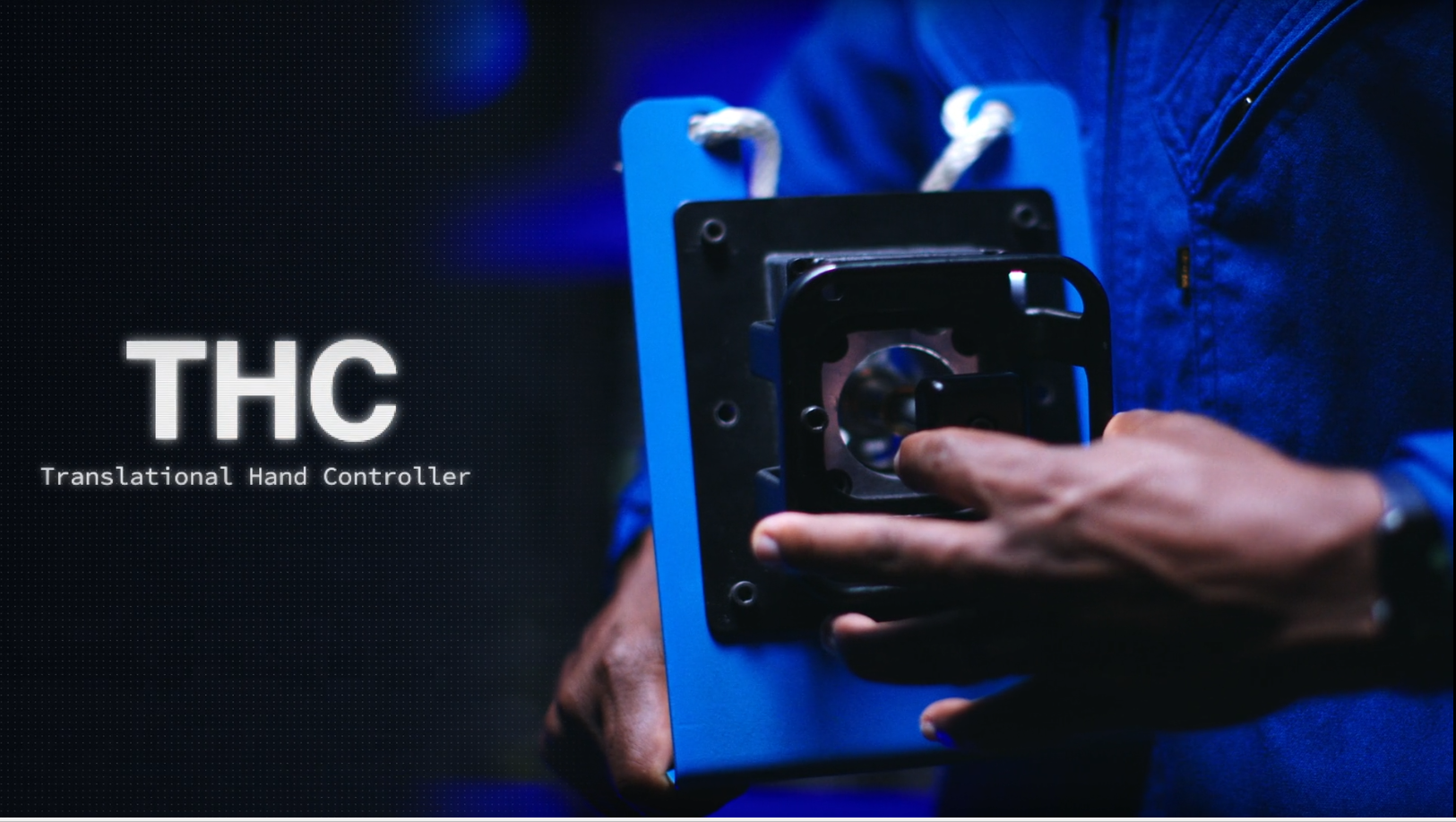
“We’re going to perform flight test objectives on Artemis II to get data on the handling qualities of the spacecraft and how well it maneuvers,” said Jeffrey Semrau, Lockheed Martin’s manual controls flight software lead for Artemis missions. “We’ll use that information to upgrade and improve our control systems and facilitate success for future missions.”
Depending on what maneuver the pilot has commanded, Orion’s software determines which of its 24 reaction control system thrusters to fire, and when. These thrusters are located on Orion’s European-built service module. They provide small amounts of thrust in any direction to steer the spacecraft and can provide torque to allow rotation control.
The cursor control device allows the crew to interact with the three display screens that show spacecraft data and information. This device allows the crew to interact with Orion even under the stresses of launch or entry when gravitational forces can prevent them from physically reaching the screens.
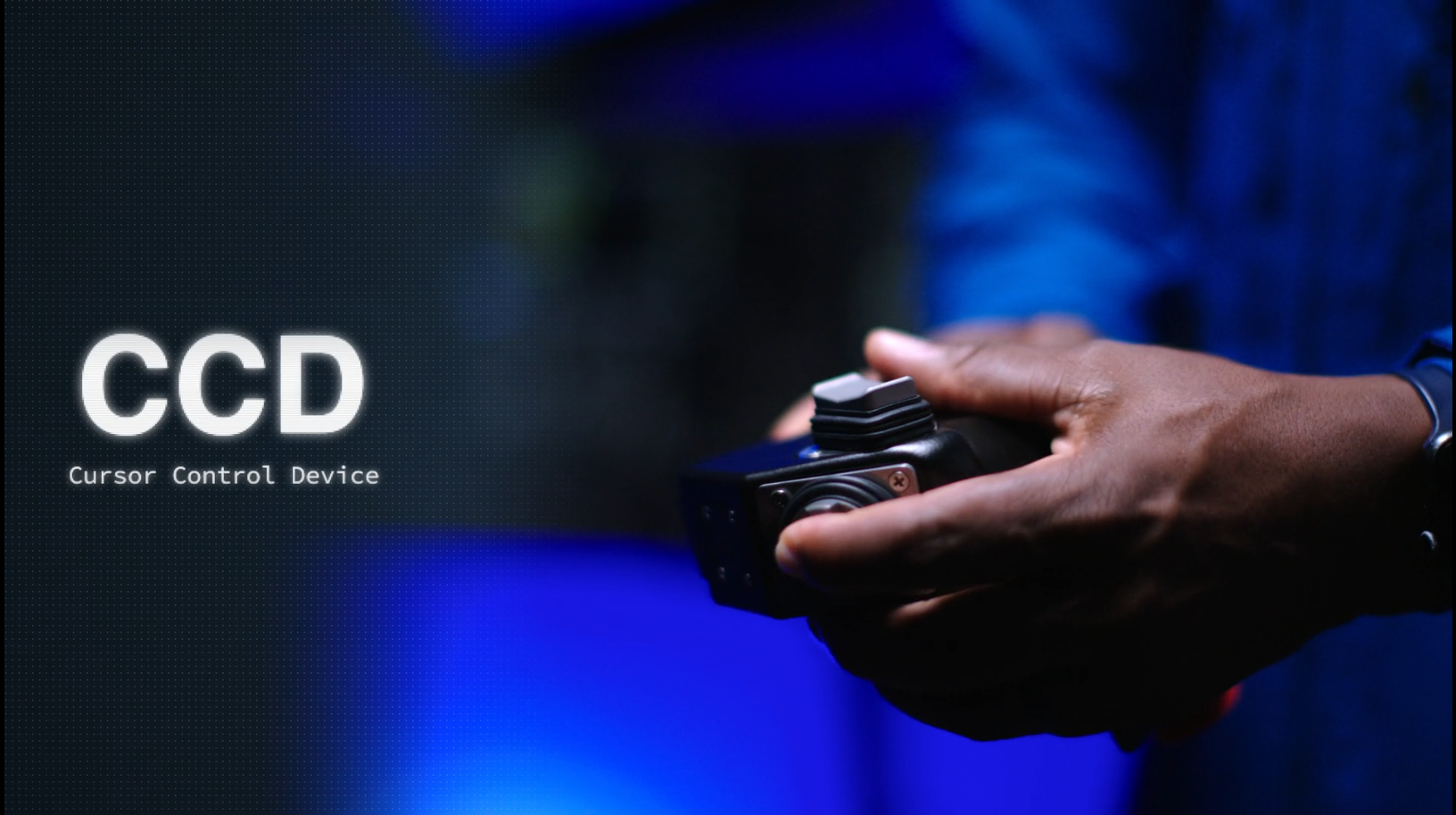
Next to Orion’s displays, the spacecraft also has a series of switches, toggles, and dials on the switch interface panel. Along with switches the crew will use during normal mission operations, there is also a backup set of switches they can use to fly Orion if a display or hand controller fails.
“This flight test will simulate the flying that we would do if we were docking to another spacecraft like our lander or to Gateway, our lunar space station,” said Victor Glover. “We’re going to make sure that the vehicle flies the way that our simulators approximate. And we’re going to make sure that it’s ready for the more complicated missions ahead.”
The approximately 10-day Artemis II flight will test NASA’s foundational human deep space exploration capabilities, the SLS rocket, Orion spacecraft, and supporting ground systems, for the first time with astronauts and will pave the way for lunar surface missions.
Quelle: NASA
----
Update: 13.02.2025
.
NASA Invites Media to Artemis II Moon Mission Activities at Kennedy
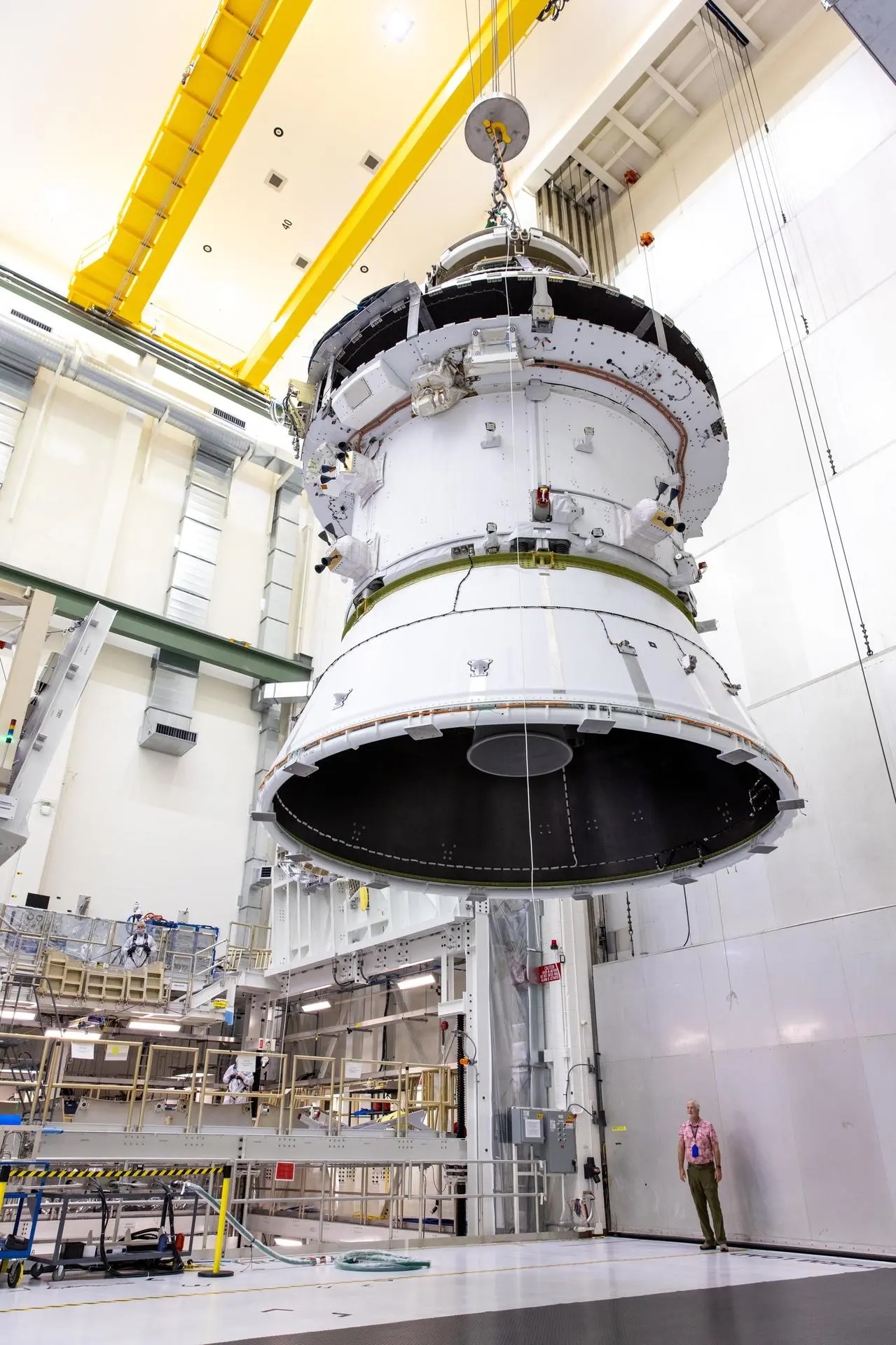
Media are invited to visit NASA’s Kennedy Space Center in Florida, to capture imagery of the agency’s Artemis II Orion spacecraft and twin SLS (Space Launch System) solid rocket boosters for the first crewed Artemis mission around the Moon. The event is targeted for Friday, March 7.
Subject matter experts from NASA and industry partners will be available for interviews.
Space is limited for this event. The deadline for foreign national media to apply is 11:59 p.m. EST, Thursday, Feb. 13. The deadline for U.S. citizens is 11:59 p.m. EST, Thursday, Feb. 20.
All accreditation requests must be submitted online at:
Credentialed media will receive a confirmation email upon approval. NASA’s media accreditation policy is available online. For questions about accreditation, or to request logistical support, email: ksc-media-accreditat@mail.nasa.gov. For other questions, please contact NASA’s Kennedy Space Center newsroom at: 321-867-2468.
Para obtener información sobre cobertura en español en el Centro Espacial Kennedy o si desea solicitor entrevistas en español, comuníquese con Antonia Jaramillo o Messod Bendayan a: antonia.jaramillobotero@nasa.gov o messod.c.bendayan@nasa.gov.
Through Artemis, NASA will send astronauts to explore the Moon for scientific discovery, economic benefits, and build the foundation for the first crewed missions to Mars.
Quelle: NASA
----
Update: 22.02.2025
.
Artemis II Rocket Booster Stacking Complete

NASA/Kim Shiflett
Engineers at NASA’s Kennedy Space Center in Florida completed stacking the twin SLS (Space Launch System) solid rocket boosters – seen in this Feb. 19, 2025, photo – inside the Vehicle Assembly Building for the agency’s Artemis II crewed test flight around the Moon.
During stacking operations, which began Nov. 20, 2024, technicians used a massive overhead crane to lift each booster segment into place on mobile launcher 1, the 380-foot-tall structure used to process, assemble, and launch the SLS rocket and Orion spacecraft.
Quelle: NASA
----
Update: 12.03.2025
.
Artemis II Upper Stage Delivered to Kennedy
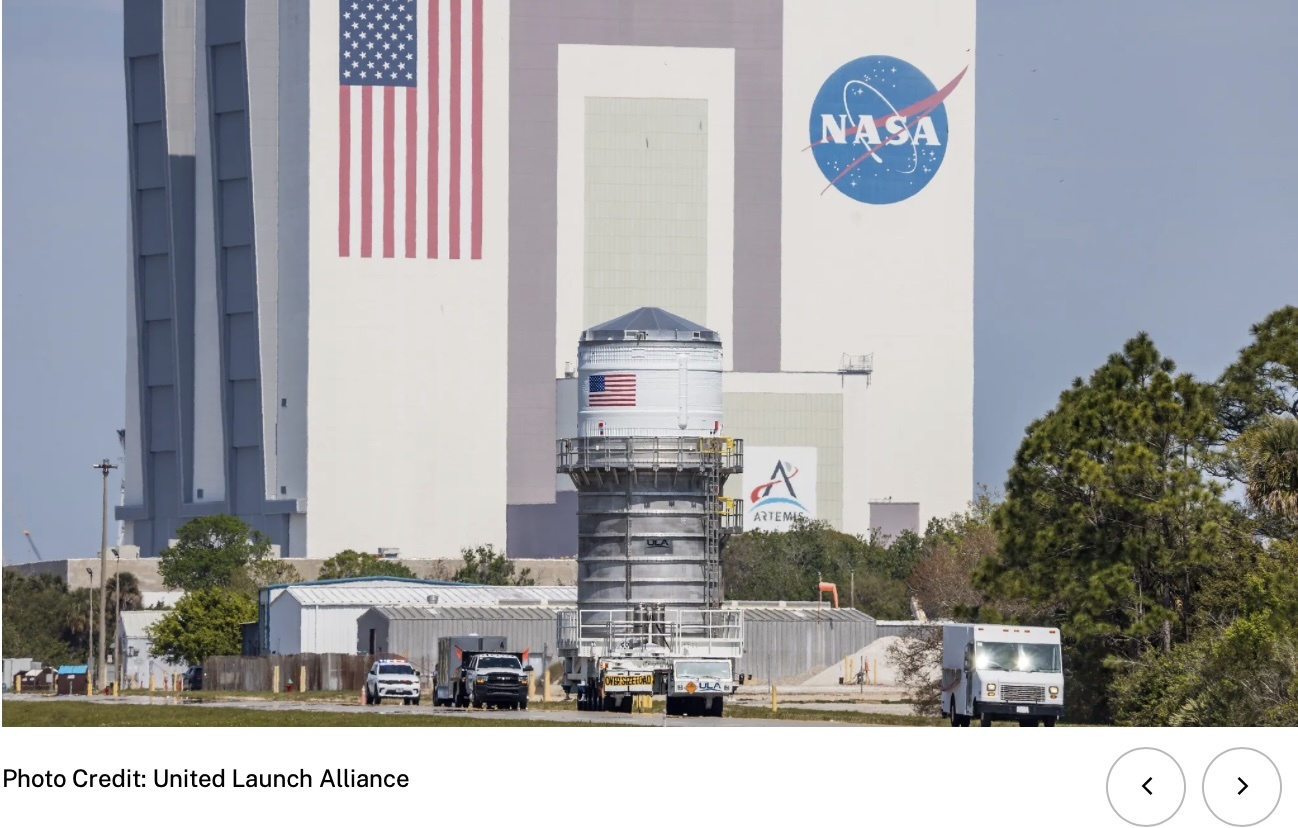
NASA received the upper stage for the agency’s Artemis II SLS (Space Launch System) rocket on Mar. 9 supplied by Boeing and United Launch Alliance (ULA). Known as the interim cryogenic propulsion stage, it arrived at the Multi Payload Processing Facility (MPPF) at NASA’s Kennedy Space Center in Florida.
The upper stage traveled to the spaceport from ULA’s Delta Operations Center at Cape Canaveral Space Force Station.
While at the MPPF, technicians will fuel the SLS upper stage with hydrazine for its reaction control system before transporting it to the center’s Vehicle Assembly Building for integration with SLS rocket elements atop mobile launcher 1. The rocket’s solid rocket booster segmentsare already assembled for launch and the core stage soon will be integrated, as will the launch vehicle stage adapter. The upper stage will be mated to the adapter.
The four-story propulsion system is powered by an RL10 engine, which will provide Orion with the boost it needs to orbit Earth twice before venturing toward the Moon.
Quelle: NASA
----
Update: 16.03.2025
.
NASA Artemis II Core Stage Goes Horizontal Ahead of Final Integration
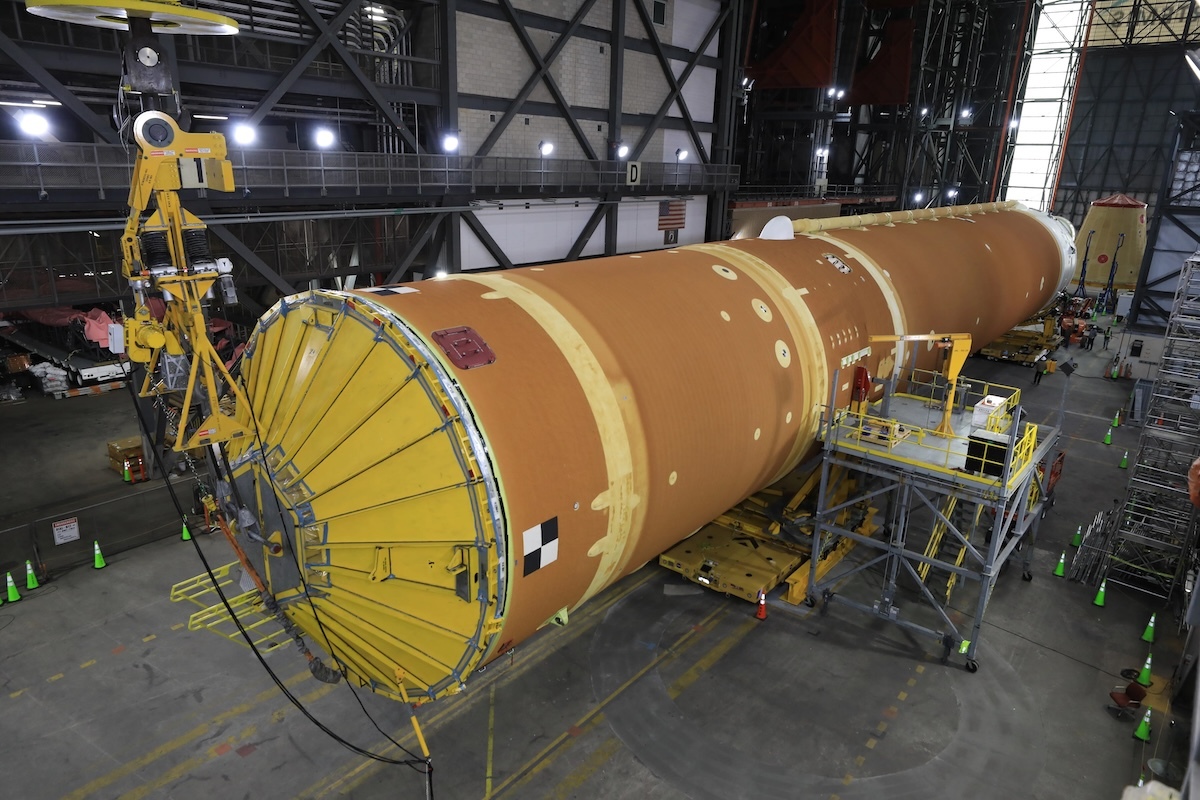
Technicians used massive cranes inside NASA’s Vehicle Assembly Building (VAB) at the agency’s Kennedy Space Center in Florida to lift the SLS (Space Launch System) core stage out of High Bay 2 and into a horizontal position in the facility’s transfer aisle. The move, completed on March 14, prepares the stage for integration with other elements of the rocket later this month.
The operation entailed vertically hoisting the 212-foot tall core stage, which weighs about 219,000 pounds with its engines, out of a stand it had been in since December that allowed engineers 360-degree access to interior and exterior elements of the rocket to enable final assembly and inspection activities.
In the transfer aisle, technicians will conduct final checkouts of the core stage before it is integrated with the completed twin solid rocket booster segments. During integration operations, teams with NASA’s Exploration Ground Systems Program will lift and secure the rocket stage atop the mobile launcher inside High Bay 3 in the VAB.
Next year, the Artemis II mission will carry four astronauts – NASA astronauts Reid Wiseman, Victor Glover, and Christina Koch, and CSA (Canadian Space Agency) astronaut Jeremy Hansen – around the Moon. The mission is the first crewed flight under NASA’s Artemis campaign and is another step toward missions on the lunar surface and helping the agency prepare for future human missions to Mars.
Quelle: NASA
----
Update: 23.03.2025
.
NASA’s Artemis II Orion Service Module Buttoned Up for Launch
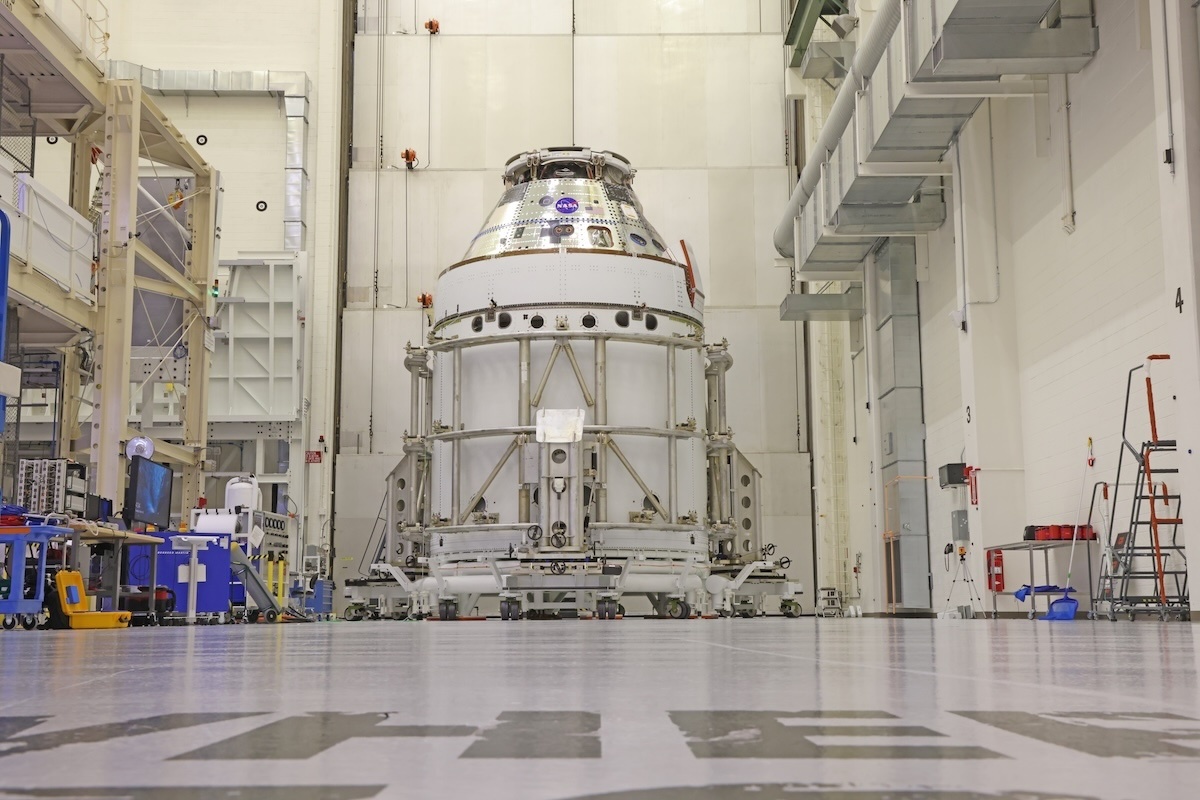
Technicians with NASA and Lockheed Martin fitted three spacecraft adapter jettison fairing panels onto the service module of the agency’s Orion’s spacecraft. The operation completed on Wednesday, March 19, 2025, inside the Neil A. Armstrong Operations and Checkout Building at NASA’s Kennedy Space Center in Florida.
The European-built service module is the powerhouse that will propel the spacecraft to the Moon. Its four solar array wings which were installed to its exterior in early March. The latest addition of fairing panels on Orion’s service module will protect the solar array wings, shielding them from the heat, wind, and acoustics of launch and ascent, and also help redistribute the load between Orion and the massive thrust of the SLS (Space Launch System) rocket during liftoff and ascent. Once the spacecraft is above the atmosphere, the three fairing panels will separate from the service module, allowing the wings to unfurl.
In addition to power, the service module will provide propulsion and life support including thermal control, air, and water for the Artemis II test flight, NASA’s first mission with crew under the Artemis campaign that will send NASA astronauts Reid Wiseman, Victor Glover, and Christina Koch, as well as CSA (Canadian Space Agency) astronaut Jeremy Hansen, on a 10-day journey around the Moon.
Through the Artemis campaign, NASA will send astronauts to explore the Moon for scientific discovery, economic benefits, and to build the foundation for the first crewed missions to Mars – for the benefit of all.
Quelle: NASA
----
Update: 26.03.2025
.
NASA’s Artemis II Core Stage Integration Complete at Kennedy
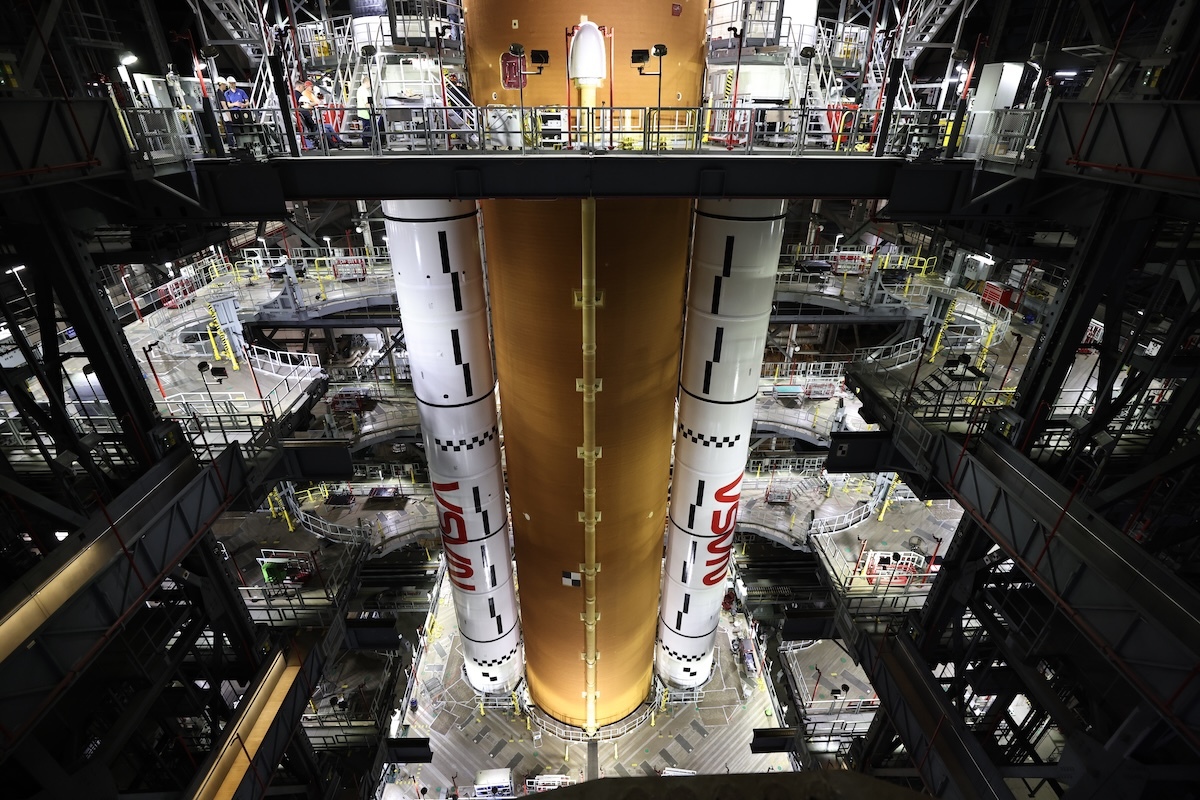
Another element of the SLS (Space Launch System) rocket for Artemis II is poised for flight. Technicians joined the core stage March 23 with the stacked solid rocket boosters for the mission at NASA’s Kennedy Space Center in Florida.
Teams with NASA’s Exploration Ground Systems Program and primary contractor Amentum used one of the five overhead cranes inside the spaceport’s Vehicle Assembly Building to lift the rocket stage from the facility’s transfer aisle to High Bay 3, where it was secured between the booster segments atop the launch tower.
As the newest addition to the mobile launcher, the core stage is the largest component of the rocket, standing 212 feet tall. The stage is the backbone of the rocket, supporting the launch vehicle stage adapter, interim cryogenic propulsion stage, Orion stage adapter, and the Orion spacecraft for the agency’s crewed Artemis II mission. The adapter will be the next element integrated and will be lifted and secured atop the core stage in the coming weeks.
The Artemis II test flight will take a crew of four astronauts on a 10-day journey around the Moon, helping confirm the foundational systems and hardware needed for human deep space exploration. The mission is the first crewed flight under NASA’s Artemis campaign and is another step toward missions on the lunar surface and helping the agency prepare for future human missions to Mars.
Quelle: NASA
----
Update: 2.04.2025
.
NASA Trains for Orion Water Recovery Ahead of Artemis II Launch
Preparations for NASA’s next Artemis flight recently took to the seas as a joint NASA and Department of Defense team, led by NASA’s Exploration Ground Systems Program, spent a week aboard the USS Somerset off the coast of California practicing procedures for recovering the Artemis II spacecraft and crew.
Following successful completion of Underway Recovery Test-12 (URT-12) on Monday, NASA’s Landing and Recovery team and their Defense Department counterparts are certified to recover the Orion spacecraft as part of the upcoming Artemis II test flight that will send NASA astronauts Reid Wiseman, Victor Glover, and Christina Koch, as well as CSA (Canadian Space Agency) astronaut Jeremy Hansen, on a 10-day journey around the Moon.
“This will be NASA’s first crewed mission to the Moon under the Artemis program,” said Lili Villarreal, the landing and recovery director for Artemis II. “A lot of practice led up to this week’s event, and seeing everything come together at sea gives me great confidence that the air, water, ground, and medical support teams are ready to safely recover the spacecraft and the crew for this historic mission.”
Once Orion reenters Earth’s atmosphere, the capsule will keep the crew safe as it slows from nearly 25,000 mph to about 325 mph. Then its system of 11 parachutes will deploy in a precise sequence to slow the capsule and crew to a relatively gentle 20 mph for splashdown off the coast of California. From the time it enters Earth’s atmosphere, the Artemis II spacecraft will fly 1,775 nautical miles to its landing spot in the Pacific Ocean. This direct approach allows NASA to control the amount of time the spacecraft will spend in extremely high temperature ranges.
The Artemis II astronauts trained during URT-11 in February 2024, when they donned Orion Crew Survival System suits and practiced a range of recovery operations at sea using the Crew Module Test Article, a stand -in for their spacecraft.
For the 12th training exercise, NASA astronauts Deniz Burnham and Andre Douglas, along with ESA (European Space Agency) astronaut Luca Parmitano, did the same, moving from the simulated crew module to USS Somerset, with helicopters, a team of Navy divers in small boats, NASA’s open water lead – a technical expert and lead design engineer for all open water operations – as well as Navy and NASA medical teams rehearsing different recovery scenarios.
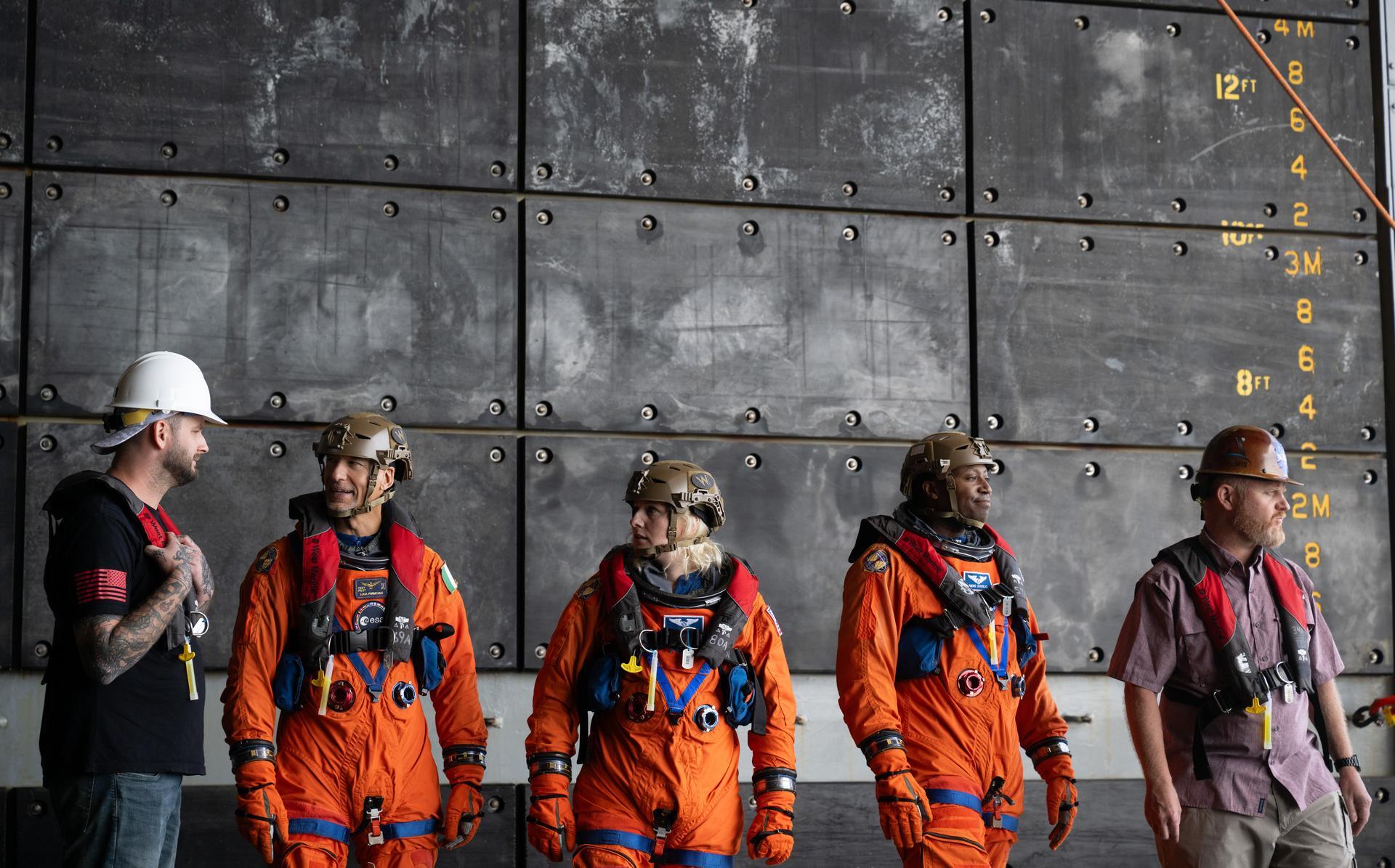
“Allowing astronauts to participate when they are not directly involved in a mission gives them valuable experience by exposing them to a lot of different scenarios,” said Glover, who will pilot Artemis II. “Learning about different systems and working with ground control teams also broadens their skillsets and prepares them for future roles. It also allows astronauts like me who are assigned to the mission to experience other roles – in this case, I am serving in the role of Joe Acaba, Chief of the Astronaut Office.”
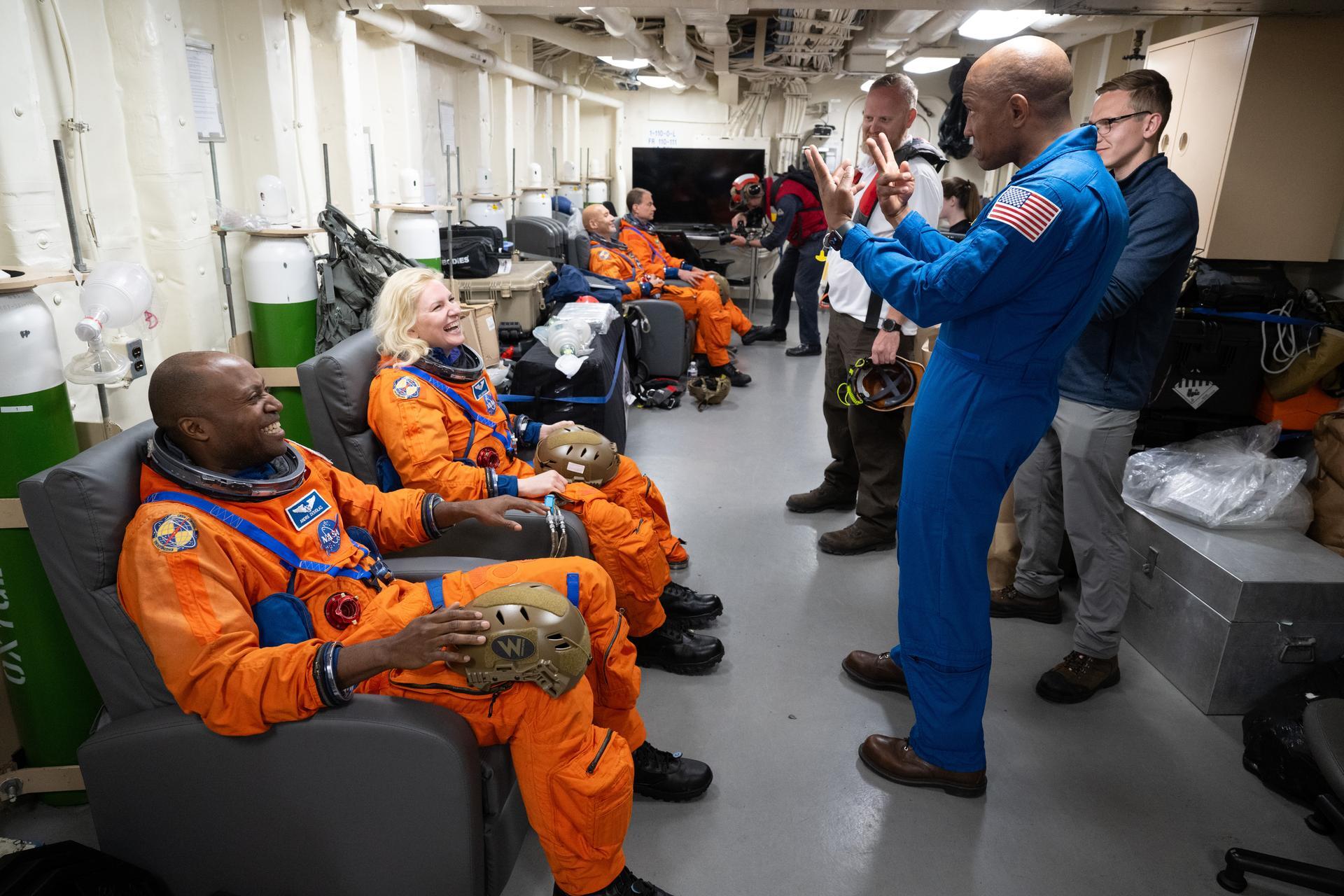
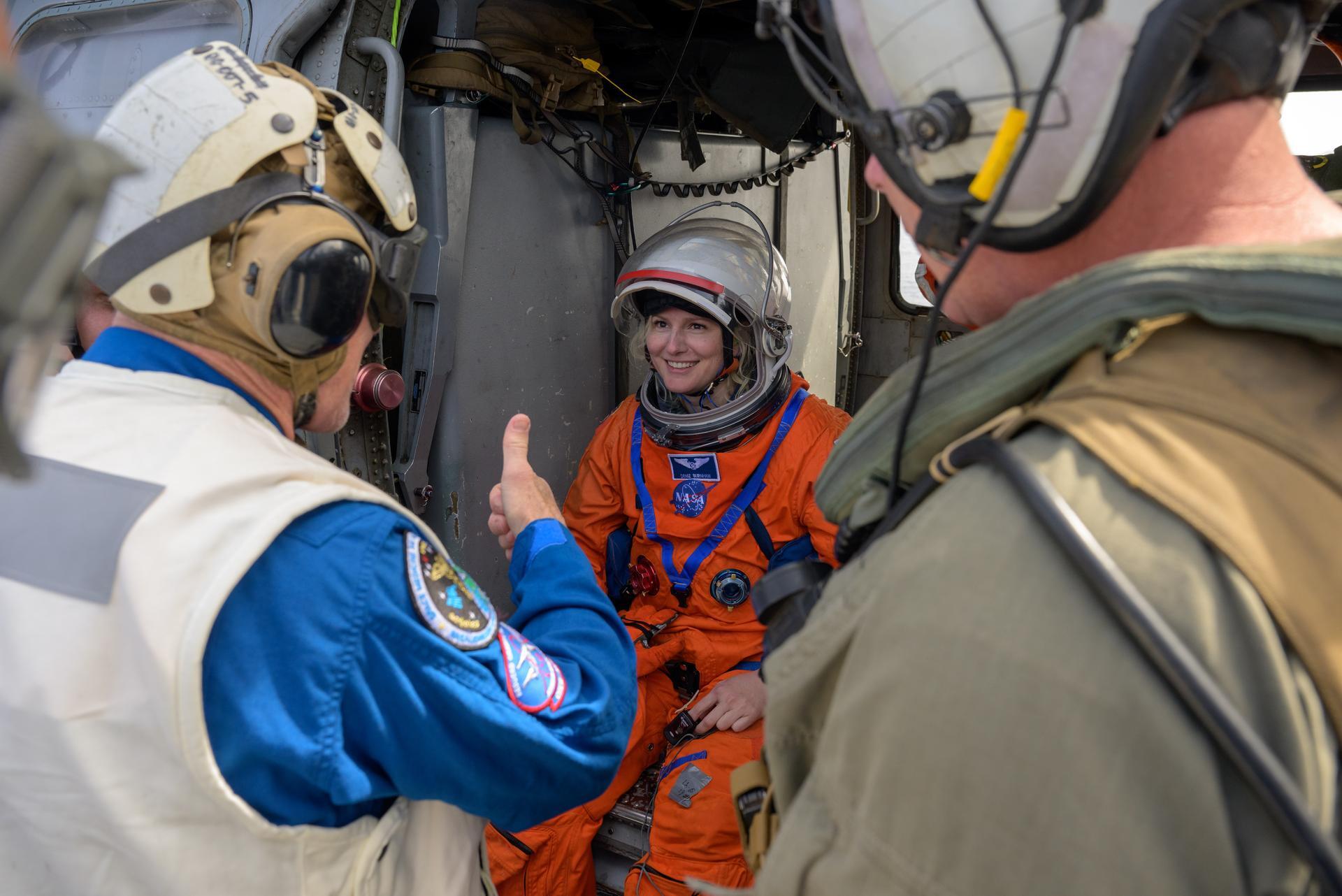
As the astronauts arrive safely at the ship for medical checkouts, recovery teams focus on returning the spacecraft and its auxiliary ground support hardware to the amphibious transport dock.
Navy divers attach a connection collar to the spacecraft and an additional line to a pneumatic winch inside the USS Somerset’s well deck, allowing joint NASA and Navy teams to tow Orion toward the ship. A team of sailors and NASA recovery personnel inside the ship manually pull some of the lines to help align Orion with its stand, which will secure the spacecraft for its trip to the shore. Following a safe and precise recovery, sailors will drain the well deck of water, and the ship will make its way back to Naval Base San Diego.
The Artemis II test flight will confirm the foundational systems and hardware needed for human deep space exploration, taking another step toward missions on the lunar surface and helping the agency prepare for human missions to Mars.
Quelle: NASA
+++
Artemis II Core Stage Integration – Complete!
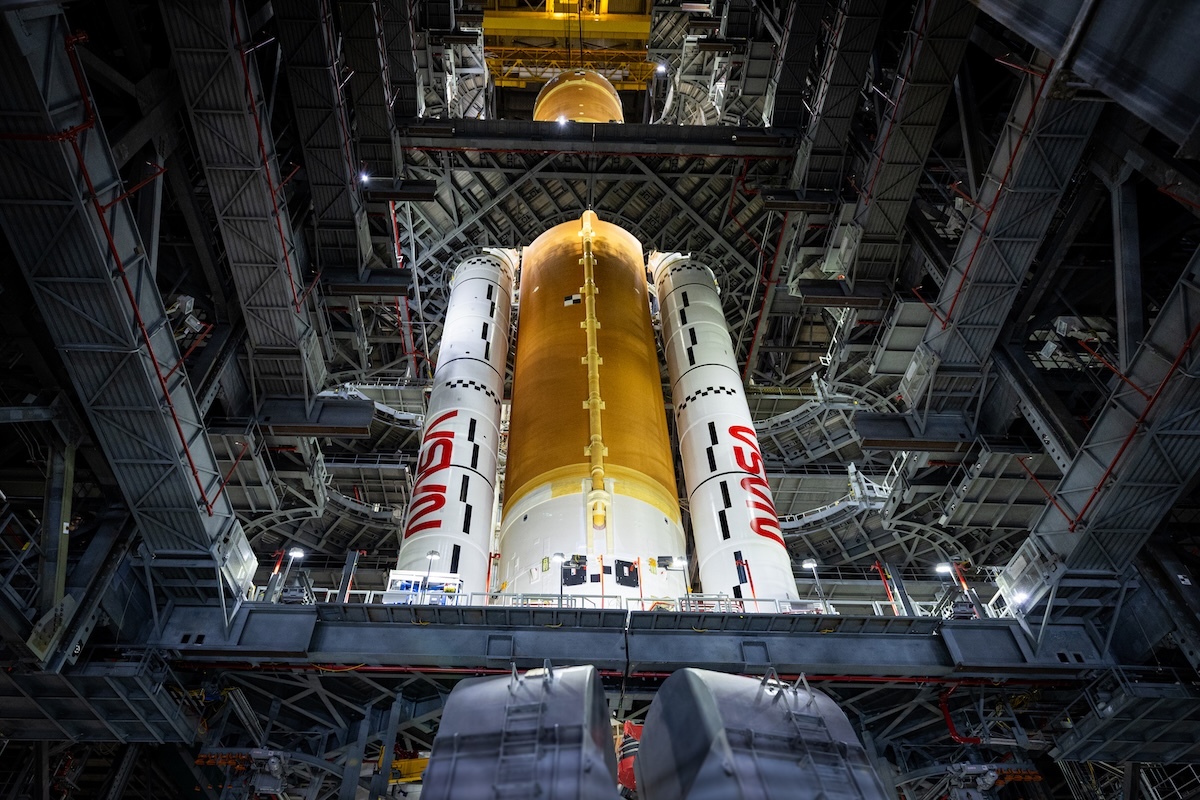
Technicians from NASA and primary contractor Amentum join the SLS (Space Launch System) rocket with the stacked solid rocket boosters for the Artemis II mission at NASA’s Kennedy Space Center in Florida on March 23, 2025. The core stage is the largest component of the rocket, standing 212 feet tall and weighing about 219,000 pounds with its engines. The stage is the backbone of the rocket, supporting the launch vehicle stage adapter, interim cryogenic propulsion stage, Orion stage adapter, and the Orion spacecraft.
Artemis II is the first crewed test flight under NASA’s Artemis campaign and is another step toward missions on the lunar surface and helping the agency prepare for future human missions to Mars.
Image credit: NASA/Frank Michaux
Quelle: NASA
----
Update: 5.04.2025
.
Artemis II Insignia Honors All

The four astronauts who will be the first to fly to the Moon under NASA’s Artemis campaign have designed an emblem to represent their mission that references both their distant destination and the home they will return to. The crew unveiled their patch in this April 2, 2025, photo.
The crew explained the patch’s symbolism, and its play on the abbreviation of Artemis II to AII, with the following description: The Artemis II test flight begins when a mighty team launches the first crew of the Artemis generation. This patch designates the mission as “AII,” signifying not only the second major flight of the Artemis campaign, but also an endeavor of discovery that seeks to explore for all and by all. Framed in Apollo 8’s famous Earthrise photo, the scene of the Earth and the Moon represents the dual nature of human spaceflight, both equally compelling: The Moon represents our exploration destination, focused on discovery of the unknown. The Earth represents home, focused on the perspective we gain when we look back at our shared planet and learn what it is to be uniquely human. The orbit around Earth highlights the ongoing exploration missions that have enabled Artemis to set sights on a long-term presence on the Moon and soon, Mars.
Commander Reid Wiseman, pilot Victor Glover, and mission specialist Christina Koch from NASA, and mission specialist Jeremy Hansen from CSA (Canadian Space Agency), will venture around the Moon in 2026 on Artemis II. The 10-day flight will test NASA’s foundational human deep space exploration capabilities, the SLS rocket, Orion spacecraft, for the first time with astronauts. Through Artemis, NASA will send astronauts to explore the Moon for scientific discovery, economic benefits, and build the foundation for the first crewed missions to Mars.
Quelle: NASA
----
Update: 16.04.2025
.
NASA Artemis II Moon Rocket Gets New Addition
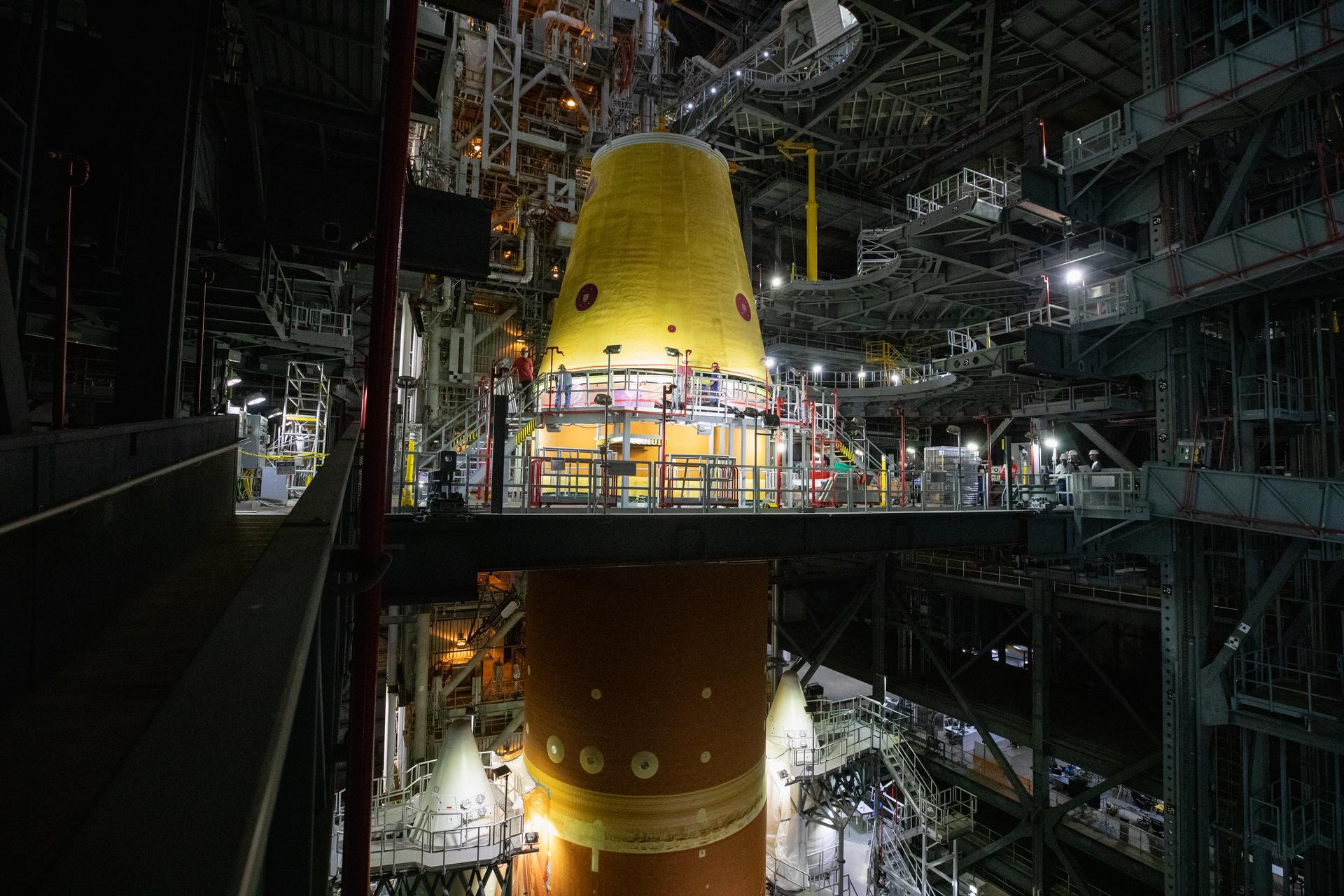
NASA’s Artemis II Moon rocket is taking shape following the successful integration of the launch vehicle stage adapter onto the SLS (Space Launch System) core stage on April 12 inside the Vehicle Assembly Building at the agency’s Kennedy Space Center in Florida. Technicians with NASA’s Exploration Ground Systems Program used a 325-ton crane to hoist the launch vehicle adapter almost 250 feet in the air and slowly lower it onto the core stage.
The cone-shaped adapter connects the interim cryogenic propulsion stage, which will propel the Artemis II test flight around the Moon, to the SLS core stage. During launch and ascent, the launch vehicle stage adapter provides structural support and protects avionics and electrical devices within the upper stage from extreme vibrations and acoustic conditions. Up next, teams will stack the interim cryogenic propulsion stage onto the launch vehicle stage adapter.
The stage adapter is manufactured by prime contractor Teledyne Brown Engineering, under the Amentum Space Exploration Division’s ESSCA (Engineering Services and Science Capability Augmentation) contract, using self-reacting friction-stir robotic and vertical weld tools at NASA’s Marshall Space Flight Center in Huntsville, Alabama. The launch vehicle stage adapter arrived at Kennedy in September of 2024 on NASA’s Pegasus barge.
The Artemis II test flight will take a crew of four astronauts on a 10-day journey around the Moon, helping confirm the foundational systems and hardware needed for human deep space exploration. The mission is the first crewed flight under NASA’s Artemis campaign and is another step toward missions on the lunar surface and helping the agency prepare for future human missions to Mars.
Quelle: NASA
----
Update: 4.05.2025
.
Rocket Upper Stage Integrated as Preparations for Artemis II Continue
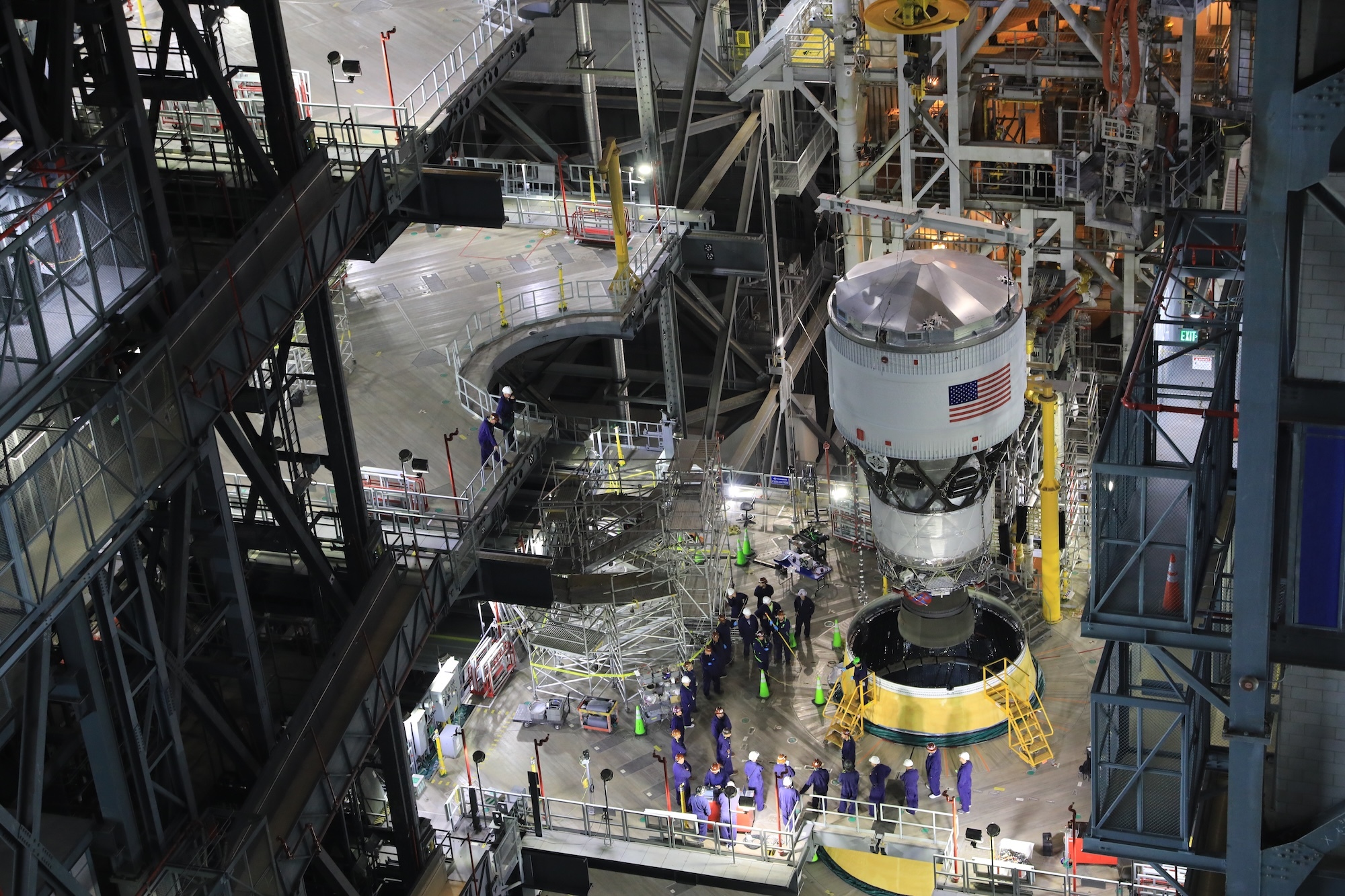
Engineers at NASA’s Kennedy Space Center in Florida successfully integrated the SLS (Space Launch System) rocket’s upper stage May 1, inside the Vehicle Assembly Building, marking another key step toward preparing to launch the agency’s Artemis II crewed test flight around the Moon.
Technicians with NASA’s Exploration Ground Systems Program stacked the upper stage, known as the interim cryogenic propulsion stage, atop the SLS’s launch vehicle stage adapter. The four-story propulsion system, built by Boeing and ULA (United Launch Alliance), is powered by an RL10 engine that will enable Orion to orbit the planet twice, once in high-Earth orbit, and build up enough speed for the push toward the Moon. The crew also will use the detached stage as a target during a manual piloting demonstration several hours after launch.
The SLS upper stage arrived in March to Kennedy’s Multi Payload Process Facility from ULA’s Delta Operations Center at nearby Cape Canaveral Space Force Station. At the MPPF, engineers loaded the stage with hydrazine to fuel its reaction control system.
The rocket, now with its upper stage integrated, sits atop mobile launcher 1 where its solid rocket boosters, core stage, launch vehicle stage adapter already are assembled together. The rocket elements will undergo integrated testing to ensure all of its components are communicating properly with each other, ground system equipment, and the Launch Control Center before the Orion stage adapter and spacecraft are stacked on top.
Artemis II will be the first test flight of the SLS rocket, Orion spacecraft, and supporting ground system with crew aboard. NASA astronauts Reid Wiseman, Victor Glover, and Christina Koch, and CSA (Canadian Space Agency) astronaut Jeremy Hansen will venture around the Moon and back. The mission is another step toward missions on the lunar surface and helping the agency prepare for future astronaut missions to Mars.
Quelle: NASA
----
Update: 5.05.2025
.
Lockheed Martin Completes Orion Development For Artemis II Mission To The Moon
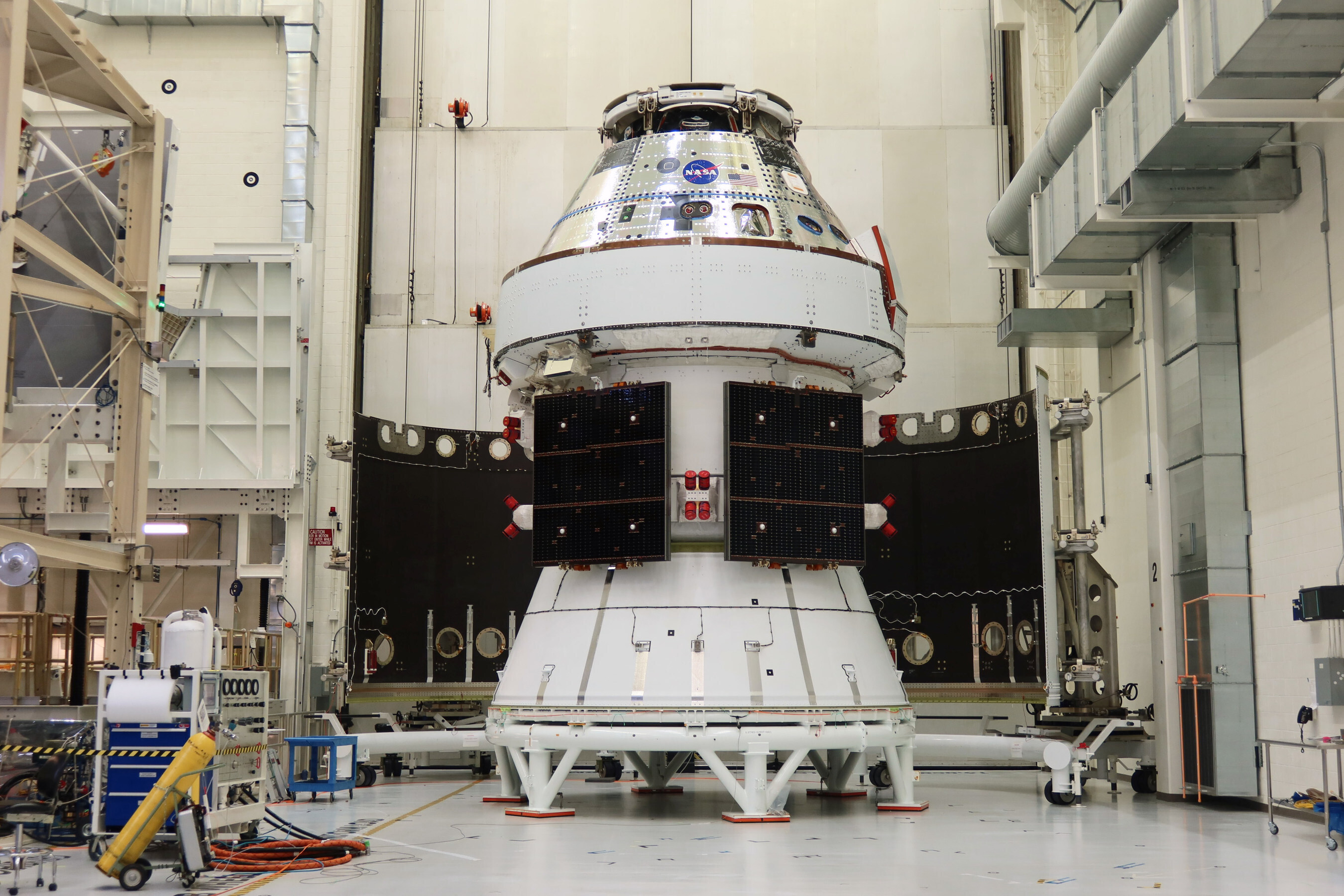
Lockheed Martin [NYSE: LMT] has completed assembly and testing of NASA's Orion Artemis II spacecraft, transferring possession to NASA's Exploration Ground Systems (EGS) team today. This milestone is a significant step for NASA and the Artemis industry team, as they prepare to launch a crew of four astronauts to further the agency's mission in establishing a human presence on the Moon for exploration and scientific discovery. It will also help build the foundation for the first crewed missions to Mars.
Orion is the most advanced, human-rated, deep space spacecraft ever developed. Lockheed Martin is the prime contractor to NASA for Orion and built the crew module, crew module adaptor and launch abort system.
"This achievement is a testament to our employees and suppliers who have worked tirelessly to get us to this important milestone," said Kirk Shireman, vice president of Human Space Exploration and Orion program manager at Lockheed Martin. "The Orion spacecraft completion for Artemis II is a major step forward in our nation's efforts to develop a long-term lunar presence. It's exciting to think that soon, humans will see the Earth rise over the lunar horizon from our vehicle, while also traveling farther from Earth than ever before."
Upgraded for Crew Onboard
The uncrewed EFT-1 and Artemis I test flights were the first steps in validating the spacecraft's core systems. Artemis II will put Orion through its final tests in deep space with a crew on board and will include learnings and significant enhancements gleaned from the Artemis I mission.
To support the health and safety of the crew, new systems have been added, which include life support – air, water, thermal control, waste management – displays and controls, audio communications, an exercise machine and a fully functional Launch Abort System. Additionally, the vehicle is outfitted with a subset of docking sensors and an experimental laser communication system, enabling high data-rate communications and paving the way for future missions.
Path to Launch
With the completion of Orion, the EGS team will perform final preparations on the spacecraft, readying it for launch. Orion will soon be moved from the Neil Armstrong Operations and Checkout Building at NASA's Kennedy Space Center to various processing facilities. This is where EGS will load propellants and other consumables, such as water and oxygen, and install the launch abort system and its protective fairings. Upon completion, it will then be transported to the Vehicle Assembly Building, lifted onto the Space Launch System (SLS) rocket and undergo final preparations for launch.
Historic Artemis Flight
Scheduled to launch in early 2026, Artemis II and the Orion spacecraft will host NASA astronauts Reid Wiseman, Victor Glover, Christina Koch and Canadian astronaut Jeremy Hansen. Their 10-day journey will include flying 4,600 miles beyond the Moon and back to Earth.
During the mission, the crew will evaluate the spacecraft's performance, test its navigation and communication systems, and conduct a series of scientific experiments. They will perform a rendezvous operation with the SLS upper stage, practicing docking activities needed for future missions including Artemis III – which will mark the first human lunar landing since Apollo 17 in 1972.
With work on Orion for Artemis II completed, Lockheed Martin continues to develop and assemble Orion spacecraft for future Artemis missions. Artemis III and IV vehicles are in the Operations and Checkout Building, while the pressure vessel is being welded at NASA's Michoud Facility in New Orleans. Lockheed Martin is on contract to develop Orion spacecraft up to Artemis VIII and has decreased cost with each vehicle.
Quelle: Lockheed Martin
